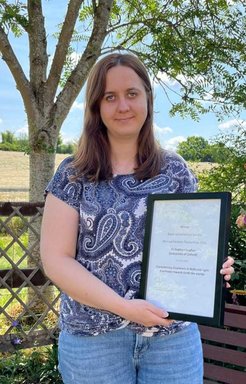Michael Penston Prize of the Royal Astronomical Society for Sophia Vaughan
Sophia Vaughan, postdoctoral researcher in the Atmospheric Physics of Exoplanets (APEx) department at MPIA in Heidelberg, has been awarded the Michael Penston Thesis Prize by the British Royal Astronomical Society (RAS) for her doctoral thesis.
The Michael Penston Thesis Prize is awarded yearly by the RAS for the best doctoral thesis in the field of astronomy or astrophysics and comes with a prize money of £ 1,000. In addition, prize winners are often invited to present the results of their work at a meeting of the renowned society. The prize is named after the astronomer Michael Penston (1943-1990).

Sophia Vaughan was honored for her thesis entitled "Characterizing exoplanets in reflected light: a pathway towards Earth-like worlds."
In her work, Sophia Vaughan focuses on the methodology and future possibilities of making significant contributions to the characterization of exoplanets through direct spectral analysis of the reflected light from these planets - with a particular focus on potentially Earth-like planets.
Direct observations of exoplanets – planets that are orbiting other stars – remains one of the greatest challenges in astrophysics today. Like the planets in our solar system, Earth-like (rocky) exoplanets shine in the reflected light of their parent star, which appears many, many orders of magnitude brighter. In addition to high sensitivity and high contrast, such observations also require extremely high spatial resolution since the angular distances between parent stars and their orbiting exoplanets are very small due to the large distances of such planetary systems from Earth.
Even with the currently available large telescopes, it is not easy to detect an exoplanet through direct imaging. And it is currently practically impossible to obtain sufficiently high-resolution spectra of Earth-like exoplanets based solely on their reflected light (meaningful spectra of exoplanets can currently only be obtained in the rare cases of so-called transits, in which a planet passes in front of its star and the starlight shines through the atmosphere of the exoplanet).
However, with the European Southern Observatory's Extremely Large Telescope (ELT) and its instruments expected to come into operation at the end of the decade, such investigations could become reality. In her work, Sophia Vaughan has for example carried out simulations to estimate what can be expected from observations of Proxima b using the high-resolution spectrograph HARMONI mounted at the ELT. Proxima b is considered the closest potential Earth-like planet. It orbits Proxima Centauri, the star closest to our Sun and about 4 light-years away, in its habitable zone – an area where liquid water is possible. Sophia Vaughan's work outlines how such research will become possible and what role it can play in characterizing Earth-like planets.
The Royal Astronomical Society (RAS) is the UK's member organization of the International Astronomical Union (IAU) and one of the most renowned astronomical societies.
News release of the Royal Astronomical Society
KJ/SV
